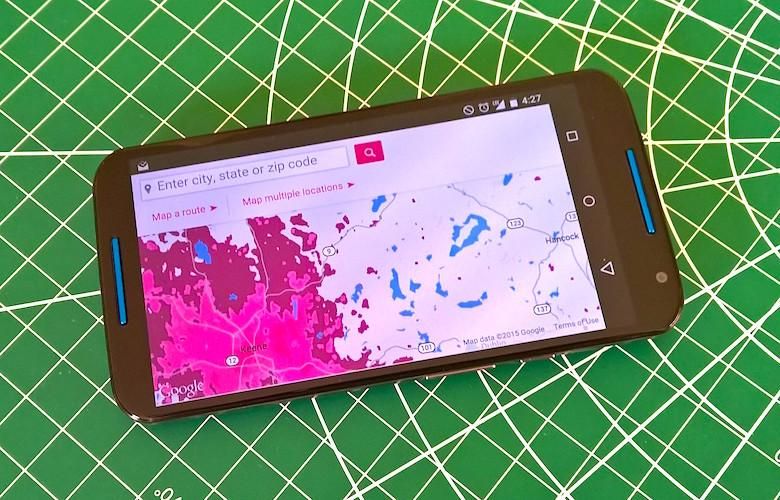After over two years on AT&T, Michael Fisher recently made the switch to T-Mobile US for his personal smartphone account. This is the second in a series of posts about the experience. (For those who prefer to start at the beginning, part 1 is here)
•
It’s not T-Mobile’s fault that its network failed at precisely the moment the Pocketnow Weekly podcast needed it the most, but it sure didn’t help ease my transition to the “Uncarrier” lifestyle.
Regular Weekly listeners know what I’m talking about: during the recording of episode 135, a score of technical issues struck our weekly podcast all at once. In the mayhem, Google (whose Hangouts service forms the bedrock of the Weekly) booted me from all Google Apps services, demanding that I login again with the code the company had just texted to me – a code I had no way of retrieving because my T-Mobile phone, along with untold thousands of others in the northeastern United States, suddenly couldn’t connect to the network. The outage lasted several hours, requiring me to fall back on an AT&T review device until service was restored.
You sure don’t make it easy to leave.
Occasional service problems are nothing new for wireless carriers. Sprint has long suffered from a reputation for poor coverage thanks to a litany of technical issues; AT&T spent years digging itself out of the capacity crunch the iPhone brought to its network; and even the largest and “most reliable” US carrier, Verizon Wireless, has seen the occasional hiccup. So it’s hard to come down on T-Mobile too hard for an outage that lasted less than three hours, widespread though it was. (When asked about the reason for the outage, a T-Mobile spokesperson told us the company “doesn’t discuss the specifics of its technology.”)
It’s when your service starts flitting in and out under normal network conditions that you start getting a feel for the “edges” of a wireless network – the holes and dark zones where your smartphone morphs from communications device to expensive calculator. After nearly three weeks test-driving T-Mobile in 4G-soaked Boston, I finally got the chance to push the carrier’s boundaries this past weekend during a drive to South Deerfield, Massachusetts – a tiny town 90 miles inland whose super-rural environs I thought perfect for a smartphone stress test (and some Yankee Candle sniffing, but that’s a story for another post).
As it turns out, I didn’t even need to get halfway to Deerfield before feeling the familiar stress of a signal meter with more blank spots than bars.
South Deerfield, MA: T-Mobile on the left, Verizon Wireless on the right.
For all the disruptive impact T-Mobile has had on the American wireless market, one warning persists across most discussions I see: T-Mobile is great, as long as you stick to populated areas. And while I wish I could bring a bold new observation to the conversation, my experience in Western Mass only serves to bolster that reputation. I was traveling with T-Mobile service on my unlocked Moto X (2014); AT&T on a review Nexus 6; and Verizon Wireless on my girlfriend’s iPhone 6. And while I still think the Moto X is the coolest of all those handsets, there’s no getting around a sad fact: when passing through all the fringe coverage areas we found, my T-Mobile-powered handset was consistently the first phone to lose service, and the last one to regain it.
Broadly speaking, that wasn’t a huge surprise; as I said, T-Mobile’s native coverage woes in “the boonies” are well documented. What surprised me instead was the near-total lack of domestic roaming. I’d naively assumed that if my phone couldn’t find a native T-Mobile signal, it would hop over to the closest available GSM partner network (AT&T in my region). This is true in some markets and has for years been a common element of the retail sales pitch; in fact, one of the store reps who facilitated my switch to T-Mobile assured me that if I found myself without T-Mobile coverage, my phone would simply switch over to AT&T. But as I quickly learned –and as the T-Mobile coverage map clearly shows– no such partnership arrangement exists in most of Massachusetts.
The result: even when driving directly beneath an AT&T cell site –which pegged our AT&T Nexus 6 signal meter at maximum– my Moto X continued to show “Emergency Calls Only.” And all throughout the region my problems persisted. Even when I could get a usable LTE or HSPA signal outside, it would evaporate or convert into a near-useless GPRS signal the moment I stepped indoors. While AT&T and Verizon also faced major challenges in this area, they were useful far more often than their Uncarrier competitor. Once, I even found myself tethering my Moto X to my girlfriend’s iPhone just to upload an Instagram photo.
(Totally worth it.)
Is the savings you’ll find on T-Mobile worth that kind of sacrifice? The answer will depend, as always, on what coverage is like where you live and work. My 180-mile round trip is hardly representative of the entire United States; if your neck of the (literal) woods is bathed in magenta and you don’t often travel to non-covered areas, you may be right at home with T-Mobile. That’s also true if you’re willing to invest in a “glovebox phone” for emergencies: an inexpensive prepaid device on a network that offers superior coverage where you’re likely to travel.
Also, remember that what holds true in the sticks doesn’t always translate to the city. In the past 18 days, I’ve found T-Mobile’s coverage and data speeds in Greater Boston to be fantastic, from the city center to the suburban fringes. On a recent afternoon at a coffee shop where Verizon signal has been terrible for years, I was able to return my girlfriend’s internet-sharing favor: she used my T-Mobile hotspot when her iPhone wouldn’t connect. When not lending out my connection to the less fortunate, I really enjoy the freedom of consuming “unlimited” data rather than constantly worrying about a finite bucket of GBs. The signal boosters I got when I signed up have turned out to be largely unnecessary – the carrier seems to work as well as my old provider in my office. And T-Mobile’s parity even holds up underground: I still get cellular service in the subway tunnels of the MBTA, just like I did on AT&T.
Still, I’d be lying if I said I wasn’t discouraged by T-Mobile’s poor showing in the rural regions of my home state. Like many people confined to a computer for most of the work week, I try to take in as much of nature’s beauty as I can during my time off – and often that means traveling to places my smartphone now can’t always be relied upon. (Of course, as my Twitter handle implies, I almost always have another phone to fall back on – but that won’t be true for the majority of users.) While T-Mobile’s no-contract philosophy and 7-day test drive offer make “auditioning” the carrier easier than ever, everything I’ve seen thus far reinforces the warnings I’ve heard time and time again over the last few years. If you’re planning on making the switch to T-Mobile and you’re even slightly concerned about coverage issues, pore over every millimeter of that coverage map, and make every hour of that test drive count. Because when it comes to “the Uncarrier,” a serious coverage check is much more than just a pre-sale formality.
•
Wondering what made Michael jump to T-Mobile in the first place? Check out the first installment of the series here, tune in to that technically-challenged podcast for more T-Mobile insights here, and stay tuned for Michael’s impressions of the company’s international roaming experience in Europe with part 3, following MWC 2015!
Are you a current or former T-Mobile US subscriber? Sound off in the comments below telling us how your experience compares to Michael’s!




